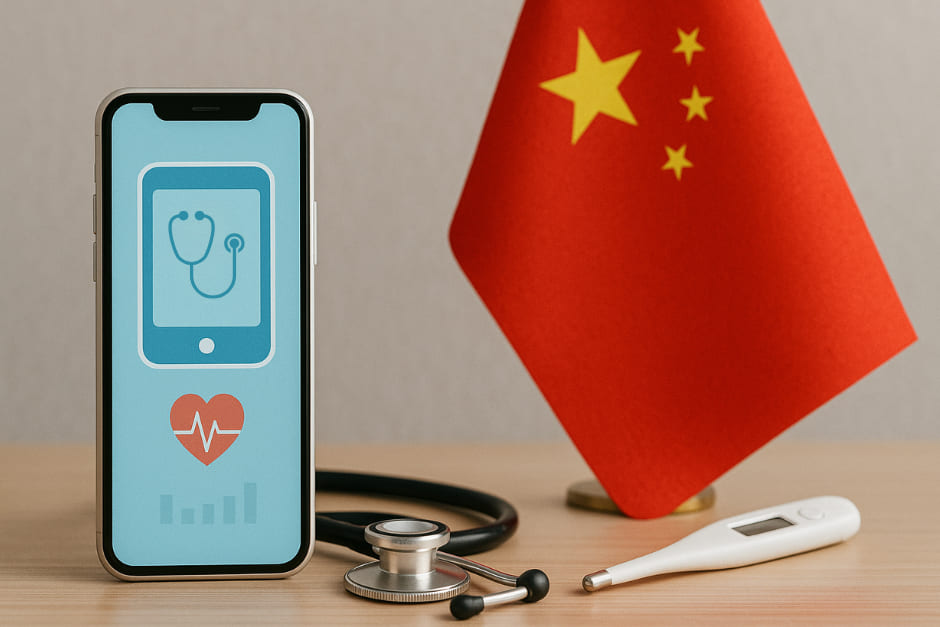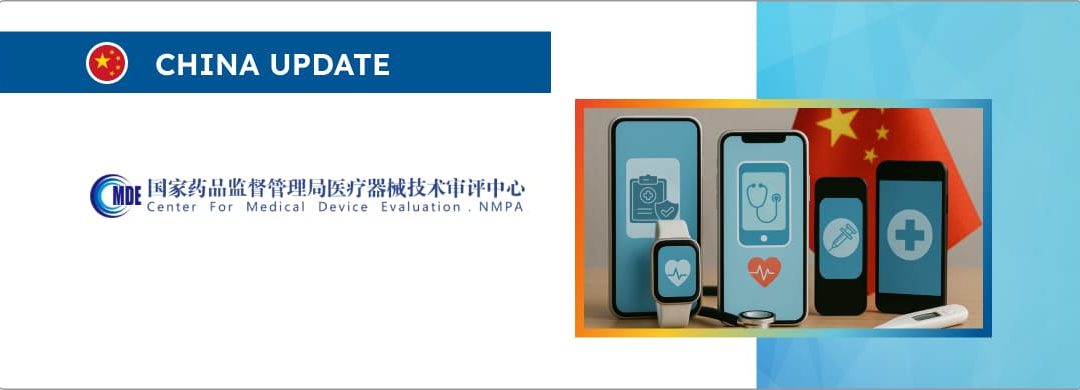The article provides a brief overview of the applicable regulatory requirements set forth under the existing legal framework for mobile medical devices.

Table of content
This article provides an overview of the revised guidance dedicated to registration of medical devices intended to be marketed and used in China. The document highlights the key points to be taken into consideration by medical device manufacturers and other parties involved in order to ensure continued compliance with the existing legal framework.
In particular, this guidance document is intended to assist applicants in preparing registration dossiers for mobile medical devices. It sets forth general technical evaluation principles while serving as a reference for quality system audits.
As a part of the digital health regulatory framework, it complements other relevant guidance documents such as those for medical device software, cybersecurity, artificial intelligence, and human factors design. It is also important to mention that the guidance is not legally enforceable but should be applied under the premise of compliance with existing laws and regulations.
Applicants may adopt alternative methods to meet regulatory requirements, provided that robust supporting evidence is submitted.
Scope of Application
The guidance is applicable to the registration of mobile medical devices categorized under Class II and Class III, including in vitro diagnostic (IVD) medical devices. Additionally, it can serve as a reference document during quality system audits for such products.

Key Concepts
First of all, the document provides definitions of the key concepts and terms used in the context of medical devices.
Definition of Mobile Medical Devices
The term “mobile medical device” refers to medical devices that utilize mobile computing technologies to perform their intended functions. These devices typically operate via non-invasive mobile computing terminals – smart devices used by healthcare professionals, patients, or other users.
These terminals may be:
- Medical terminals, which are designed or customized by the applicant and are considered part of the medical device system.
- General-purpose terminals, which are commercially available products possibly modified in appearance, but not inherently designed for medical use, and not considered part of the product.
These terminals can be handheld (such as tablets and smartphones), wearable (such as smartwatches or glasses), or a hybrid of both.
Types of Mobile Medical Devices
Mobile medical devices can be divided into three main categories:
- Mobile Medical Equipment includes devices that rely on mobile computing platforms and additional components (such as sensors or displays) to perform their medical functions. These devices may replicate the functionality of conventional, stationary medical equipment – examples include portable ultrasound machines or mobile ECG monitors.
- Mobile Standalone Software refers to software that operates on general-purpose mobile computing devices and performs medical functions. These are similar in function to conventional medical software but differ in operational environments and technical platforms. For instance, mobile applications for processing medical images or analyzing ECG data fall under this category.
- Mobile Medical Accessories include mobile terminals used as accessories to medical devices.
These are further divided into:
- Control-type accessories, which use mobile terminals to control the functioning of a device (e.g., software on a tablet used to operate an imaging table).
- Data-type accessories, which facilitate electronic data exchange between a medical device and a mobile terminal. If such software independently achieves medical functionality, it may be registered separately.
It is important to note that mobile computing components integral to the medical device’s intended use, such as screens, must be included in the overall registration and comply with the guidance’s requirements.
Clarification of Exclusions
Devices using mobile computing for non-medical purposes, or portable devices that do not incorporate mobile computing technology (e.g., wheeled equipment or devices mounted in vehicles or aircraft), are not considered mobile medical devices. Likewise, implantable or invasive devices are excluded unless specifically incorporating mobile computing terminals.
Fundamental Principles
The document further describes the cornerstone principles the existing legal framework is based on.
Technology-Based Assessment
The evaluation of mobile medical devices must address not only the typical risks associated with conventional equivalents but also the added risks introduced by mobile computing platforms. This includes evaluating screen visibility, data connectivity, and environmental usability.
Devices should be assessed based on their type, intended use, usage environment, and terminal characteristics.
Risk-Oriented Approach
Risk management must consider both device-specific hazards (such as electrical safety and biocompatibility) and terminal-related issues (e.g., small screens, variable brightness, limited battery life, data privacy). For example, general-purpose terminals, unlike medical terminals, are not inherently designed for clinical use and may be less reliable due to their uncontrolled software environments.
Furthermore, products intended for non-professional users or home use require careful consideration of user interface and operational safety. Applicants must ensure that all selected terminals fully support the device’s clinical functions and maintain an acceptable risk profile under expected conditions.
Lifecycle Quality Management
Like all medical software, mobile medical devices must undergo rigorous quality control across their lifecycle. Pre-market activities should include thorough validation and verification to reduce foreseeable risks, while post-market monitoring should detect and respond to previously unrecognized issues.
Technical Considerations
In order to assist the parties involved, the document also addresses the key technical considerations.
Naming Convention
Product names for mobile devices and software should conform to standard naming practices and may include “mobile” as a distinguishing descriptor.
Display Requirements
Due to the variation in clinical risks, display specifications must be appropriate for the product’s use. For instance, software used in clinical decision-making must have higher screen resolution, brightness, and response times than software used for simple data review.
Applicants should provide detailed justifications and, where applicable, clinical evaluation data supporting the chosen screen parameters.
Ambient Light Effects
Because mobile devices are often used in varying light environments, developers must mitigate the potential for misdiagnosis caused by screen glare or insufficient brightness. Devices with critical functions should incorporate ambient light sensors and automatic brightness adjustment.
Battery Life and Power Management
Many mobile medical devices are compact and have limited battery capacity, making battery performance a significant concern. For example, devices used for long-term monitoring (like wearable ECG monitors) must demonstrate battery life sufficient for clinical use, typically not less than 24 hours.
Alerts for low battery must also be included.
Software Environment and Security
General-purpose terminals often operate in open software environments, increasing the risk of unpredictable device behavior. Applicants must define the level of environment openness (closed, partially open, fully open) and implement appropriate risk mitigation strategies, such as disabling unnecessary ports or verifying the environment at startup.
Non-Professional User Design
Devices used by patients or caregivers in home settings must follow human-centered design principles. This includes presenting critical device registration information at the login interface to ensure the user is aware of product credentials.
Wearable Computing Considerations
When wearable or flexible computing technology is used, additional usability and reliability factors must be assessed. Developers must document any risks specific to wearable formats and confirm product performance through testing.
Cybersecurity Requirements
Mobile medical devices must address cybersecurity risks, including data protection, remote access control, and secure user authentication. Features such as automatic deletion or encryption of locally stored medical data upon logout should be implemented to ensure data confidentiality, particularly in clinical decision-support applications.
Registration and Testing Framework
Registration units should align with conventional counterparts. For example, mobile medical equipment should follow equipment registration pathways, while standalone software should follow software guidelines.
Accessories should be registered together with the primary device or separately, depending on functionality and necessity.
Clinical Evaluation
Mobile medical devices should be evaluated following the software clinical evaluation guidelines. When performing comparative evaluations, either a similar mobile device or a conventional device with equivalent functionality may serve as the reference product.
Mobile Terminal Research Report
A mandatory part of the registration process, this report should include:
- Basic Information: Describes the type of device, its intended use, operating environment, core features, and terminal characteristics. If multiple terminals are used, a detailed list must be provided.
- Technical Justification: Discusses how the selected terminals align with the technical criteria outlined in the guidance.
- Risk Management: Includes detailed analysis of potential risks, covering all terminals used. If part of broader software documentation, the relevant sections should be clearly referenced.
- Specification Documentation: Presents requirements for terminal performance characteristics across all devices used.
- Testing and Verification: Provides evidence of validation activities, including test plans, results, and performance verification. When using general-purpose terminals with built-in sensors, additional sensor validation must be provided.
- Traceability Analysis: Demonstrates the linkage between device requirements, design, coding units, testing, and risk controls.
- Conclusive Summary: Evaluates whether all selected terminals meet safety and effectiveness requirements based on design goals.
Registration Documentation for Different Device Types
The document further outlines the scope of supporting documentation necessary for the registration of a medical device depending on its type.
Mobile Medical Equipment
Applicants must submit the terminal research report, cybersecurity documentation, product specifications (both for clinical functions and terminal characteristics), stability data, and comprehensive instructions for use. Special attention should be given to devices used in home or non-professional settings.
Mobile Standalone Software
Similar to mobile equipment but with a focus on the software’s operating environment. Specifications for the general-purpose terminals and any built-in sensors must be documented. Stability and usage instructions should follow the same format as those for mobile equipment.
Mobile Accessories
According to the document, control-type accessories must be registered with their parent devices and follow the documentation requirements of mobile equipment. At the same time, data-type accessories may follow either mobile equipment or standalone software requirements, depending on whether they are registered independently or jointly with a medical device.
Conclusion
In summary, the present guidance provides an in-depth overview of the applicable regulatory requirements, highlighting the key points and providing vital clarifications the parties involved should consider in order to be allowed to place their products on the market.
How Can RegDesk Help?
RegDesk is an AI-powered Regulatory Information Management System (RIMS) designed to simplify global compliance for medical device companies. With regulatory intelligence covering 120+ markets, RegDesk helps you prepare and publish global submissions, manage standards, conduct impact assessments, and stay ahead of regulatory changes all from a single, centralized platform. Expanding into new markets has never been easier.

